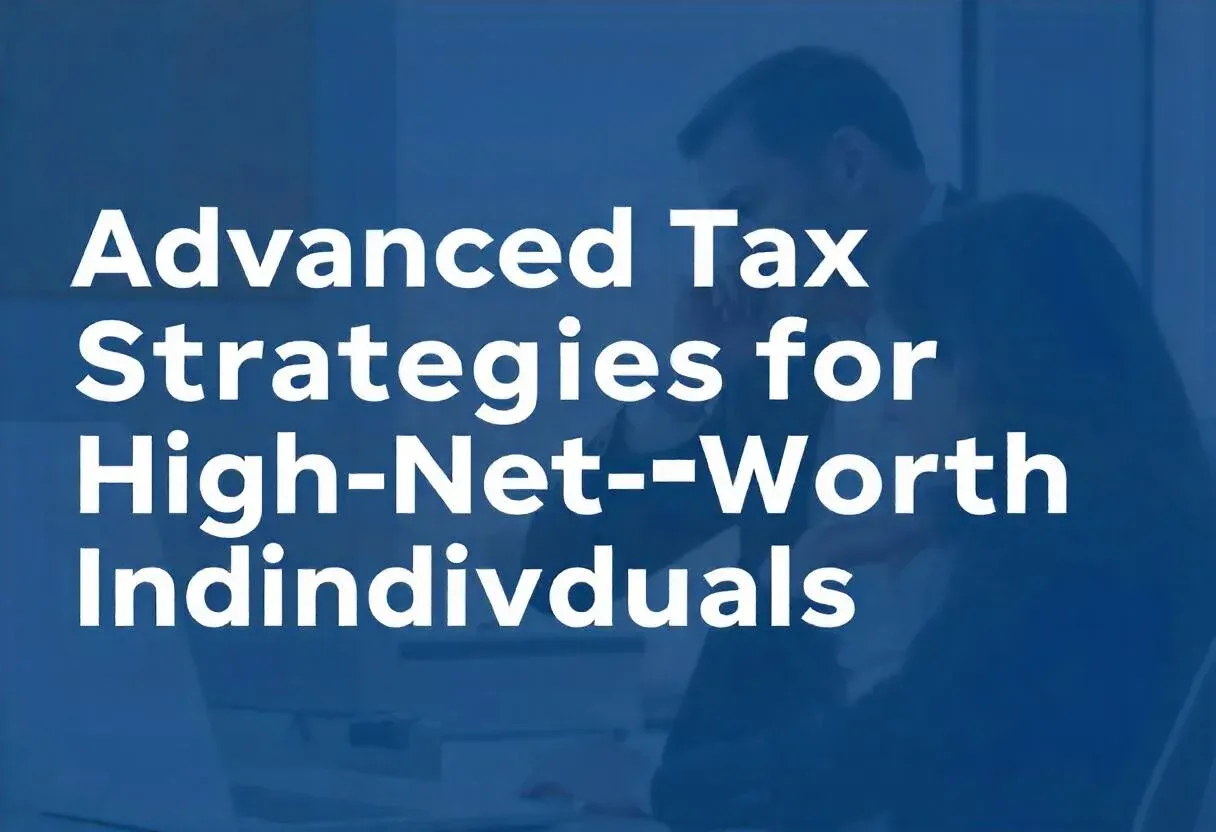Advanced Tax Strategies for High-Net-Worth Individuals in 2024
High-net-worth individuals enjoy the outcomes of utilizing multiple sophisticated tax methods that limit their tax obligations and promote and safeguard their wealth. Each of the strategic approaches has its particular elements and can be updated to meet different circumstances. What follows is a deep analysis of these methods, accompanied by illustrations and links for additional information.
Image by freepik.com
Advanced Tax Strategies for High-Net-Worth Individuals
1. Using Trusts to Keep Wealth Safe.
Tools that focus on trusts can be of great use for individuals with significant wealth to manage their assets and lower their tax obligations.
- Irrevocable Trusts: When assets are transferred into an irrevocable trust, their management rights move from the grantor while they are withdrawn from the taxable estate. A $5 million investment into an irrevocable trust, for example, promises that the money will not be subject to estate taxes after the HNWI dies. The American Bar Association supplies information that pertains to creating and managing trusts, in addition to the meaningful aspects that must be considered in legal terms.
- Dynasty Trusts: By means of family trusts, it is possible to bypass estate taxes when making generational transfers. A fact this case exemplifies is how legacy trusts held by families to manage investments for their grandchildren ensure that they build wealth tax-free for multiple generations. The comprehensive coverage of dynasty trust resources and benefits is featured on WealthCounsel’s website.
- Charitable Remainder Trusts (CRTs): A high net-worth individual (HNWI) might transfer appraised stocks, valued at $1 million, to a charitable remainder trust (CRT), and then receive a charitable tax deduction while avoiding capital gains taxes on any stock appreciation. For a definite period, the trust pays an income, and any additional assets flow to charity in that case. The National Philanthropic Trust gives resources showing the advantages of charitable remainder trusts for both donors and charity organizations.
2. Tax-Loss Harvesting
Part of a plan to minimize profits and additionally reflect losses, trading securities is a tax-loss harvesting strategy.
- If an HNWI (high net worth individual) experiences a bump of $50,000 in capital gains from selling stocks but also hits a $20,000 loss through investment losses, that’s really not great. As a particular strategy, this one stands out when it comes to the conclusion of the tax year, while people review their investments. Investopedia provides thorough information and representations of how to perform tax-loss harvesting.
3. Locating funds into Opportunity Zones
Investing resources into challenging economic settings provides major tax incentives through Opportunity Zones.
- Capital gains taxes related to their former investments can be deferred by a HNWI until 2026, or until they dispose of their QOF investment. Should they uphold the investment for ten years, the QOF investment would produce potential gains that are totally untaxed. An investor who profits $100,000 from selling stock can gracefully avoid the tax by directing this income to a QOF and may even be in a position to offset future taxes related to the growth of the QOF. The U.S. Department of the Treasury supplies resources on Opportunity Zones, together with help in making sound investments.
4. Making the Max Out of Retirement Contributions
Individuals with high net worth should attempt every method available to increase their retirement savings contributions.
- Mega Backdoor Roth IRA: This technique allows those with greater income to place their after-tax dollars into their 401(k) plans before changing these dollars into Roth IRAs. Subsequently, a person who offers up $58,000 (the maximal contribution for 2024) as part of their 401(k) can convert that money to a Roth IRA, which enables tax-free growth for that investment. Resources from Fidelity explain how to achieve success with this strategy.
- Defined Benefit Plans: These techniques are specifically tailored for people with higher incomes who desire to invest a lot into their pensions, earning praise for their tax advantages. A business owner could put together a definite benefit plan that would provide for annual contributions of up to $300,000, based on details like age and income segment. Websites like IRS.gov offer information on defined benefit plans and contribution limits.
5. An analytical analysis of depreciation in connection with real estate investments.
HNWIs have access to the special tax advantages inherent in investing in real estate.
- Depreciation Deductions: Landlords managed in real estate can depreciate their properties for claims over 27.5 years for residential ones, or 39 years for commercial. An instance can be made with an HNWI who owns a $1 million rental property, as they can claim around $36,364 ($1 million / 27.5 years) per year of taxable income deductions thanks to depreciation. BiggerPockets is important for its contribution to helpful real estate investment strategies in tandem with the advantages of depreciation.
- 1031 Exchange: This permits investors to decline capital gains taxes by investing acquisitions from one property sale in a closely related property within 180 days. In an example of this, when an investor gets rid of a $2 million commercial property and shifts that exact value into a new property, without being directly involved in the deal; they are not required to pay capital gains taxes on that property on an urgent basis. The IRS site presents specific guidelines for executing a 1031 exchange correctly.
6. Income Splitting Strategies
In an attempt to reduce their headline taxes, the procedure of splitting income among families or related entities is achieved through income splitting.
- Family Limited Partnerships (FLPs): An FLP (family limited partnership) permits assets to be combined while keeping senior-generation management decisions under the control of family members. One scenario illustrates this point: if parents contribute $1 million to an FLP with their kids as limited partners, they may give shares of the partnership each year without triggering gift taxes. They also maintain control over the assets contained in the partnership structure. Forbes publishes writings about the advantages and strategies connected to family-limited partnerships.
- Gifting Strategies: As HNWIs, it is possible to offer assets worth up to the annual exclusion limit (presently $17,000 for each recipient) without the obligation to pay gift taxes. As a demonstration, if a couple has three children and annually gives each child $17,000, they can maneuver up to $102,000 totally tax-free, without touching their lifetime exemption provisions. Websites like GiftTax.org discuss gifting strategies and limits comprehensively.
7. Utilizing Business Structures
Choosing the correct form of business organization is essential for making the greatest tax benefits.
- S-Corporations: Opting for S-Corp status gives owners the ability to lower their self-employment taxes by drawing a sensible salary for themselves and declaring profits above that without being taxed on those profits. The owner of an S-Corp pays self-employment taxes on only the salary part of their $100,000 paycheck, while they may take the remaining $50,000 as a distribution without taxation. The SBA (Small Business Administration) gives direction concerning business structure choices.
- Limited Liability Companies (LLCs): LLCs give entrepreneurs the chance to decide on a tax approach and prevent liability risks, additionally giving them access to a multitude of deductions related to their business expenses. An LLC owner is able to reduce charges on their home office and business travel vehicle expenses from their taxable income, according to a case study recently conducted in the United States. The site for the IRS contains details on LLC taxation choices and their perks.
8. Charitable Giving Strategies
Not only does philanthropy produce good in society, but it also comes with important tax advantages.
- Donor-Advised Funds (DAFs): A HNWI might provide appreciated stock valued at $500,000 to a DAF and receive an immediate charitable deduction, all while bypassing capital gains taxes on the stock's appreciation at sale, made by the fund at a later point. This suggests that they can finance charities over the years, and also take advantage of early tax incentives. The National Philanthropic Trust functions as a helpful asset when gathering knowledge about the way donor-advised funds are managed.
- Qualified Charitable Distributions (QCDs): Anyone aged 70½ or older can give up to $100,000 each year from their IRAs directly to charitable organizations, without it increasing taxable income or being part of the required minimum distributions. An example could be if a retiree offers $50,000 from their individual retirement account directly to charity using a Qualified Charitable Distribution (QCD), rather than withdrawing it and then making the gift with personal funds—this produces a decrease in their taxable income, and qualifies for the Required Minimum Distribution (RMD) demand. The AARP website provides details about how QCDs function.
9. Investment in Municipal Bonds
As part of their duties, states or local governments regularly issue bonds that constitute debt and provide tax-free interest income.
- Let’s say a HNWI places capital in municipal bonds returning 4%; the interest made from this investment is usually exempt from federal income tax—allowing the potential to save thousands as compared to bonds that yield similar rates but expose interest income to taxation. Municipal investment methods and marketplace conditions are presented in Morningstar's perspectives.
10. Cost Segregation Studies
Cost segregation studies enable property owners to speed up their depreciation deductions by recognizing personal property aspects inside real estate investments.
- A $2 million commercial real estate property belonging to an owner can go through a cost segregation study, which finds that $500,000 in personal property can be accelerated in depreciation over a five-year period, instead of the regular 39-year term for commercial buildings—a huge tax benefit in the early years of owning the property. Websites such as CostSegregationServices.com offer services related to conducting these studies effectively.
11. Tax Credits and Incentives
Staying informed about available tax credits is crucial for maximizing potential savings:
- Energy Efficiency Credits: If homeowners make investments in energy-efficient upgrades—solar panels or energy-saving windows—it may qualify them for federal credits that effectively cut thousands of dollars from their tax payments, additionally based on the installation price and reputation-specific eligibility.
- Research & Development (R&D) Tax Credits: For companies engaging in relevant R&D activities, significant federal or state credits may be available, which directly decrease their overall tax obligations based on expenditures incurred while researching innovation or product development—almost always leading to cash flow advantages for businesses that put a large emphasis on innovation. R&D Tax Credit Services offers extensive guides on the necessary qualifying activities and effective credit claim methods.
12. Estate Freeze Techniques
An estate freeze involves locking in current values for estate tax purposes while allowing future appreciation outside the estate's value calculation:
- By placing appreciating assets into an irrevocable trust with some reserved rights, an HNWI could lock in current values for estate tax purposes, while enabling future growth that remains exempt from their taxable estate calculations – ultimately saving their heirs significantly at inheritance time due to decreased overall estate valuations compared to traditional methods without value freezes involved. The IRS site provides information about estate freeze techniques, in addition to important forms required for the legal establishment of compliant transfers according to the relevant regulations!
Conclusion
Sophisticated tax strategies are available to high-net-worth individuals who seek to reduce liabilities while capturing a plentiful array of wealth-preservation possibilities for upcoming generations! Abundant clients (HNWIs) can capably navigate intricate tax scenarios and protect their financial well-being by shrewdly utilizing charitable giving tactics, artfully leveraging trusts, cleverly using their retirement accounts, penetrating their investments, selecting the right business frameworks, thoroughly exploring real estate opportunities, and regularly tap into the help of seasoned professionals who provide services.
For more information about these strategies:
- IRS
- Fidelit
- National Philanthropic Trust
These resources provide valuable insights into advanced tax strategies tailored specifically for high-net-worth individuals seeking financial optimization!



.webp)



.webp)